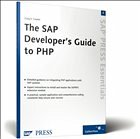Nicht lieferbar

The SAP Developer’s Guide to PHP
SAP PRESS Essentials 8
Versandkostenfrei!
Nicht lieferbar
With growing interest in the development of low cost development solutions in a corporate environment, PHP is becoming more and more popular. However, the biggest problem for most SAP developers is the need for quick information to help them hit the ground running. This SAP PRESS Essentials guide provides readers with a comprehensive assessment of what is really needed to work with PHP, as well as how the SAP and PHP systems work together. After a short introduction to PHP and its capability characteristics, the SAPRFC extension module for PHP 4 and PHP 5 is explained in detail. Working with a...
With growing interest in the development of low cost development solutions in a corporate environment, PHP is becoming more and more popular. However, the biggest problem for most SAP developers is the need for quick information to help them hit the ground running. This SAP PRESS Essentials guide provides readers with a comprehensive assessment of what is really needed to work with PHP, as well as how the SAP and PHP systems work together. After a short introduction to PHP and its capability characteristics, the SAPRFC extension module for PHP 4 and PHP 5 is explained in detail. Working with a sample application, you will learn how the two systems communicate with one another, and how best to use PHP for your own SAP-related development projects.
Highlights include:
- Introduction to PHP
- SAPRFC module in practice
- Connections with PHP to the SAP system
- Unique example application
Table of contents:
Preface 3
1. Introduction to PHP 5
1.1 The History 5
1.2 Why PHP? 6
1.3 How PHP Works 6
1.4 The Basics of Getting Started 8
2. SAPRFC and Environment 9
2.1 A Merging of Technologies 9
2.2 The Environment 10
2.3 Setting Up and Installing the Environment 10
HTTP Server 10
Installing PHP 11
Manual Configuration of HTTP Server 13
2.4 The First PHP webpage 15
2.5 SAPRFC 16
3. Connecting PHP to SAP 19
Using the Classes 20
Making the Connection 20
Calling the Function 21
Reading the Result 22
Logging Off 23
4. Example Application 25
4.1 The Problem 25
4.2 The Background 27
4.3 The System 27
5. Foundation and Connection 29
5.1 HTML and JavaScript 29
5.2 CSS 32
5.3 PHP 33
6. Beta Testing and Enhancements 47
6.1 Dynamic Login 47
Cookies 47
Sessions 48
6.2 Action Log 53
Better Display 53
Modifying 53
Deleting and Printing 56
6.3 Modify Data 57
6.4 'Bells Whistles” 62
Hiding Our Log 62
Controlling the Display of the Log 65
CSS Styles 66
Appendix 71
Index 97
Highlights include:
- Introduction to PHP
- SAPRFC module in practice
- Connections with PHP to the SAP system
- Unique example application
Table of contents:
Preface 3
1. Introduction to PHP 5
1.1 The History 5
1.2 Why PHP? 6
1.3 How PHP Works 6
1.4 The Basics of Getting Started 8
2. SAPRFC and Environment 9
2.1 A Merging of Technologies 9
2.2 The Environment 10
2.3 Setting Up and Installing the Environment 10
HTTP Server 10
Installing PHP 11
Manual Configuration of HTTP Server 13
2.4 The First PHP webpage 15
2.5 SAPRFC 16
3. Connecting PHP to SAP 19
Using the Classes 20
Making the Connection 20
Calling the Function 21
Reading the Result 22
Logging Off 23
4. Example Application 25
4.1 The Problem 25
4.2 The Background 27
4.3 The System 27
5. Foundation and Connection 29
5.1 HTML and JavaScript 29
5.2 CSS 32
5.3 PHP 33
6. Beta Testing and Enhancements 47
6.1 Dynamic Login 47
Cookies 47
Sessions 48
6.2 Action Log 53
Better Display 53
Modifying 53
Deleting and Printing 56
6.3 Modify Data 57
6.4 'Bells Whistles” 62
Hiding Our Log 62
Controlling the Display of the Log 65
CSS Styles 66
Appendix 71
Index 97



